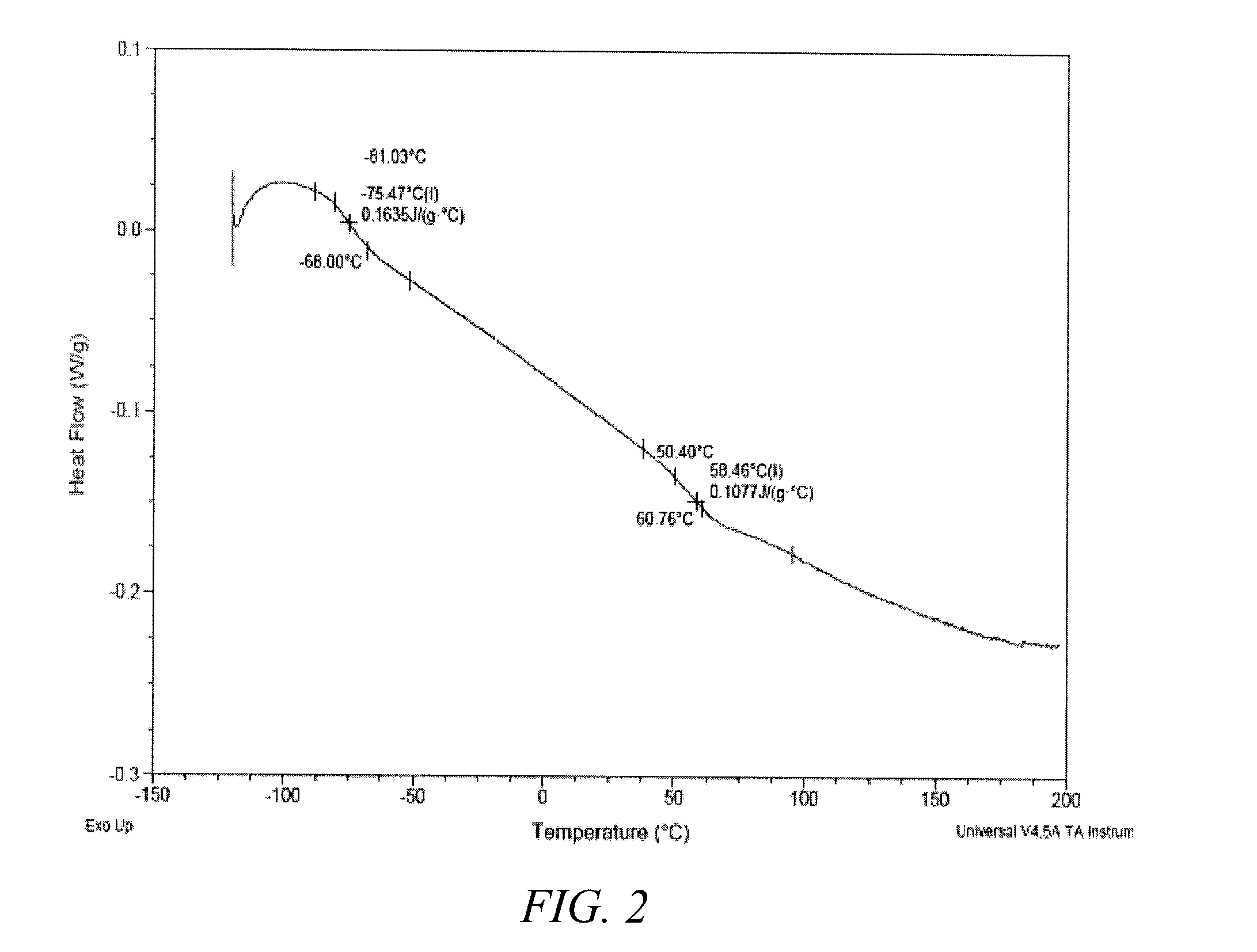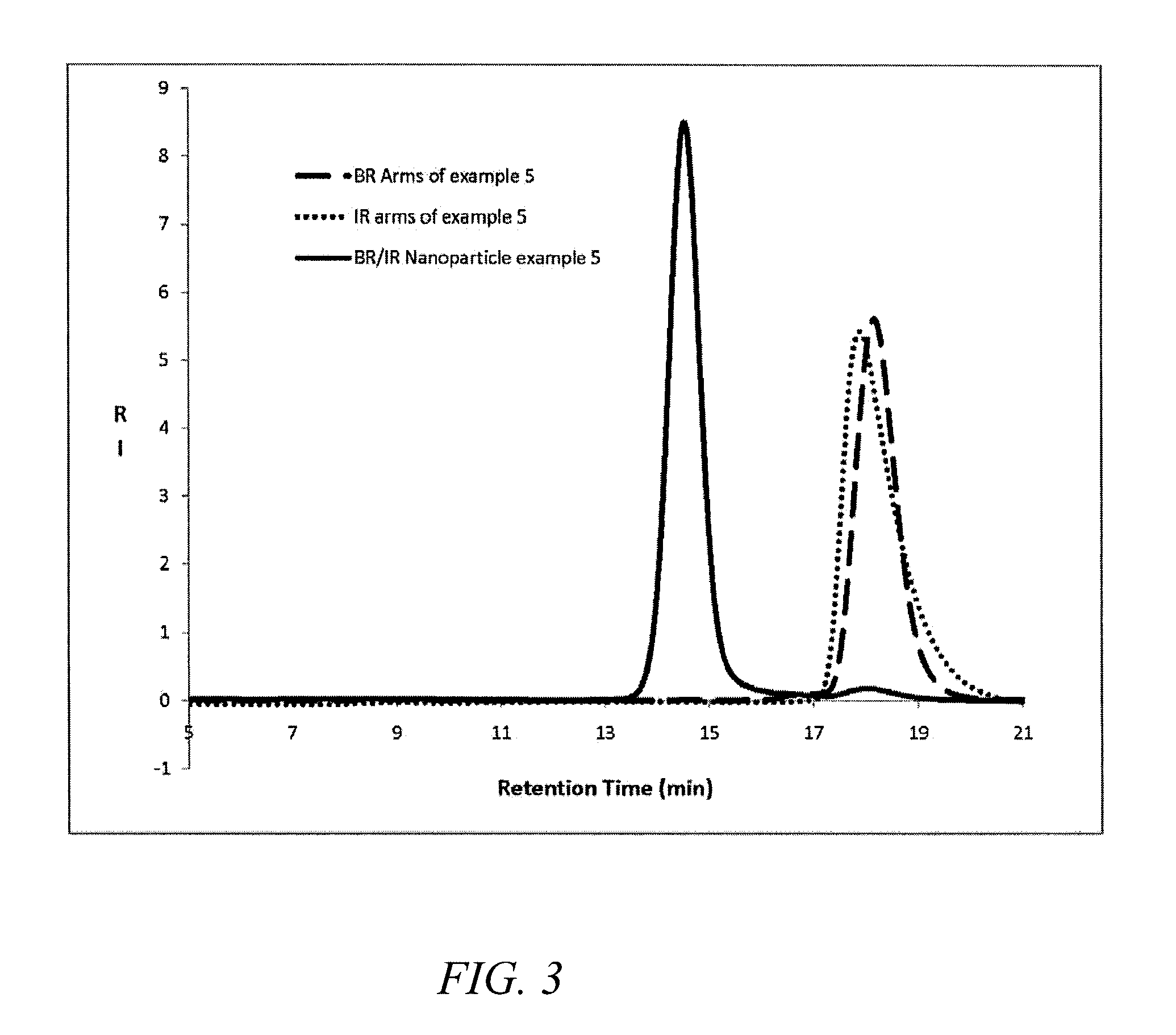Hairy Polymeric Nanoparticles With First And Second Shell Block Polymer Arms
a polymer and polymer arm technology, applied in the field of polymer janus nanoparticles, can solve problems such as degradation of matrix materials, and achieve the effect of improving the improving the various characteristics of rubber compositions
- Summary
- Abstract
- Description
- Claims
- Application Information
AI Technical Summary
Benefits of technology
Problems solved by technology
Method used
Image
Examples
example 1
Janus Nanoparticle Preparation: Separately-Prepared Arms with Post-Treatment Polarization
[0113]A first reactor (7.6 L, purchased from Chemineer, Inc.) was used to synthesize the polybutadiene (“PBd”). The reactor was first charged with 11b hexane, followed by 2.4 lbs of a butadiene / hexane blend (22 weight percent butadiene). Polymerization was initiated at 57° C. by adding 5.3 ml of 1.54 M n-butyllithium in hexane, and then was allowed to continue for two hours. A gel permeation chromatography (“GPC”) analysis of this solution indicated that the polybutadiene synthesized had a number average molecular weight (“Mn”) of 42,200 and a polydispersity (“Mw / Mn”) of 1.09.
[0114]A second reactor (7.6 L, purchased from Chemineer, Inc.) was used to make poly(t-butyl styrene) (“PtBuSt”). The second reactor was first charged with 0.51 lbs of t-butyl styrene, followed by 3 lbs of hexane. Polymerization was initiated at 57° C. by adding 3 ml of 1.6 M oligomeric oxolanyl propanes in hexane and 4 ml ...
example 2
Janus Nanoparticle Preparation with Polar Monomer
[0117]In this example, nanoparticles bearing poly(2-vinylpridine) (“P2VP”) arms and poly(butadiene) (“PBd”) arms were synthesized. The PBd arms were synthesized first, and the living ends of the PBd arms were then used to initiate the polymerization of a small amount of divinylbenzene and styrene, yielding PBd arm nanoparticles bearing a number of active sites within their cores. Subsequently, P2VP arms were grown from the active cores of the PBd arms. The following details the procedure.
[0118]To a clean, dry 28 oz. beverage bottle was added 100 g of purified hexane, 100 g of 22 weight percent butadiene in hexane solution. Next, 0.3 ml of 1.6 molar oligomeric oxolanyl propanes and 0.3 ml of 1.6 molar n-butyl lithium in hexane solution were added to the bottle. The solution was then stirred for 1 hour before 5 ml of DVB and styrene in hexane solution (styrene 29 weight percent, DVB 12.5 weight percent in hexane) was added to the bottle...
example 3
Preparation of Janus Nanoparticle-Containing Rubber Compositions
[0119]Three rubber compositions were prepared according to the formulation shown in Table 2, below, by selectively using the Janus nanoparticle material prepared in Example 2 to replace part of the styrene-butadiene rubber (“SBR”) polymer in the compound formulation (“Rubber Sample 1”). Two control samples were prepared for comparison (“Rubber Sample 2” and “Rubber Sample 3”).
TABLE 2Composition of Rubber Samples 1-3RubberRubberRubberComponent*Sample 1Sample 2Sample 3styrene-Butadiene Rubber19010090Example 2 (Janus Nanoparticle)15——Silica Filler (SiO)2707085Aromatic Oil303030Wax1.501.501.50Stearic acid2.002.002.00Santoflex 13 (antioxidants)0.950.950.95Si-69 (silane coupling agent)8.008.008.00Sulfur1.701.701.70N-(cyclohexylthio)phthalimide0.250.250.25(retarder)Zinc oxide2.502.502.50Cyclohexyl-benzothiazole1.501.501.50sulfenamide (accelerator)Diphenylguanidine (accelerator)0.500.500.50*Component concentrations given in par...
PUM
| Property | Measurement | Unit |
|---|---|---|
| Temperature | aaaaa | aaaaa |
| Temperature | aaaaa | aaaaa |
| Percent by mass | aaaaa | aaaaa |
Abstract
Description
Claims
Application Information
 Login to View More
Login to View More - R&D
- Intellectual Property
- Life Sciences
- Materials
- Tech Scout
- Unparalleled Data Quality
- Higher Quality Content
- 60% Fewer Hallucinations
Browse by: Latest US Patents, China's latest patents, Technical Efficacy Thesaurus, Application Domain, Technology Topic, Popular Technical Reports.
© 2025 PatSnap. All rights reserved.Legal|Privacy policy|Modern Slavery Act Transparency Statement|Sitemap|About US| Contact US: help@patsnap.com



